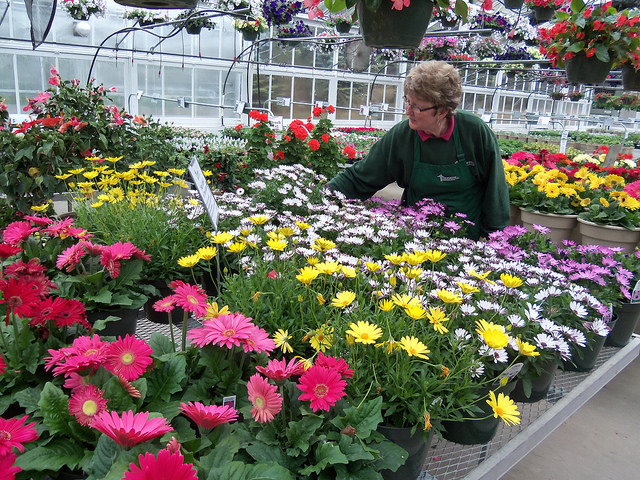by Dennis Dalman
news@thenewsleaders.com
It’s OK to love your plants; just don’t love them to death.
That’s a good bit of advice from Arno Shermock, owner of Thomsens Greenhouse and Garden Center near St. Joseph. Loving a plant to death means giving it more care than it really needs, such as overwatering and overfertilizing.
“It’s important to find a balance between too much and not enough,” Shermock said. One way to do that is to read and heed directions on fertilizer products and water only when the top half inch or so of the soil is dry. Killing plants with love can happen to green plants, flowers and even trees and shrubs, Shermock noted.
There are many good fertilizers available, but at Thomsens, they have had good luck with Miracle Gro and Bloombusters, Shermock noted. But no matter which product someone chooses, always follow the directions carefully, he added.
Underwatering, of course, is the other extreme. Some people think their hanging baskets outdoors need only a little drizzle of water. As a result, it isn’t long before the flowers wilt and die. Outdoor baskets and containers dry out quickly in the sun. When they are watered, they should be drenched until water is running out of the bottoms. Then let them dry out a bit so the top inch or so of soil is dry, then (usually the next day in hot summer weather), give them another good soaking.
Be sure to prune
Chickie Meyer is the production manager for Thomsens. One of her perennial tips, every spring, is to warn customers about the dangers of overwatering and overfertilizing. Another favorite tip is to encourage customers not to be afraid to pinch and prune and cut back plants. Almost every plant benefits from some judicious pruning every two weeks or so through the growing season. Unpruned plants and flowers will tend to get scraggly or spindly. Wave petunias are good examples of why pinching back is important. Some customers have learned if they pinch them back (leaves, stems and blooms) right after planting, they will be fuller and bloom longer. During the season, petunias can get spindly with long branches and fewer blooms. Cutting them back every two weeks will help them look better and bloom longer, with a compact and full look, Meyer noted.
Some people think mistakenly that plants will die if a leaf, stem or bloom is cut off.
“Don’ be shy about pinching and clipping plants,” she said. “Pinch them back every two weeks or so.”
When to plant?
Meyer and Shermock are often asked the Big Spring Question: When to plant? Unfortunately there is no definite answer as neither Shermock nor Meyer have a crystal ball. Some, Shermock said, like to plant on May 15. Others, however, insist planting shouldn’t begin until right after Memorial Day when the danger of a killing frost is likely not possible.
Most plants should never be put in until the ground is nice and warm, Meyer advises. It depends on the plants and flowers, however. Petunias and geraniums can handle chilly weather better than most. Impatiens and coleus, on the other hand, do not handle chilly nights very well.
Most container plants can be planted now, Meyer said, but she cautions people to keep a daily watch on overnight temperatures. If there is the slightest danger the temps could get down into the low to mid-30s, the containers should be taken into the house or they should be covered with blankets, towels or some other material.
For overall, general planting, Meyer tends to go by her “Lilac Rule.” When lilac bushes start to bud, hardier plants can be planted. When lilacs start to bloom, anything can be planted.
Another tip customers should remember is to keep an eye on their yards from sunup to sundown, carefully noting where there are areas of full sun and areas of full or partial (dappled) shade. Then, when planning a garden or flower bed, use that sun-shade information when buying plants and flowers. Some, like petunias, like full sun (six or more hours of sun per day); others, like coleus and most hostas, prefer shade or dappled shade.
Favorites
It’s too early in the season to determine customers’ new favorites, Shermock noted.
“One year a certain color of flower won’t sell, and the next year it will be really hot,” he said. “Yellow is a good example. For years there was virtually no interest in yellow. Now it’s a hot color. Same with orange.”
Geraniums – red, orange, pink, white – are a big seller every year at area greenhouses, Shermock said, noting that it’s Thomsens’ biggest “crop.” Many who buy geraniums also buy spike accent plants because the two go so well together.
Hanging baskets are the pride and joy of Thomsens. One woman drives down every spring from Duluth just to purchase Thomsens’ hanging flower baskets. They are, she’s told Shermock, the very best and most beautiful of any hanging baskets of any greenhouse between Duluth and St. Cloud.
Thomens’ staff creates 6,000 10-inch hanging baskets and about 1,500 14-inch baskets.
Other big sellers are petunias in all their varieties.
Thomsens carries about one million plants, shrubs, trees and flowers every year, Shermock said. Thomsens offers about 600 varieties of perennials (plants that come up every year) and 700 varieties of annuals (those that live only one season).
Thomsens employs 30 workers during May, its peak month.
photo by Dennis Dalman
After a long, cold winter, it’s time to plant. JoAnn Fleischhacker, an Albany resident, tends to a small field of daisies at Thomsens Greenhouse and Garden Center near St. Joseph.





